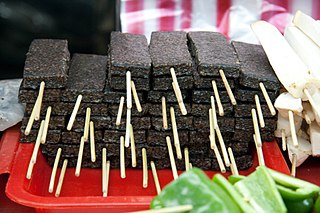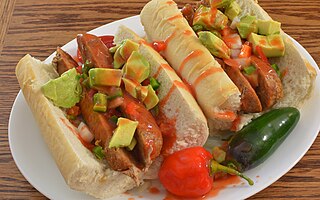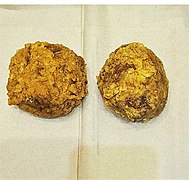
Cajun cuisine is a subset of Louisiana cooking developed by the Cajuns, itself a Louisianan development incorporating elements of Native American, West African, French, and Spanish cuisine.

The cuisine of the Southern United States encompasses diverse food traditions of several subregions, including cuisine of Southeastern Native American tribes, Tidewater, Appalachian, Ozarks, Lowcountry, Cajun, Creole, African American cuisine and Floribbean, Spanish, French, British, and German cuisine. In recent history, elements of Southern cuisine have spread to other parts of the United States, influencing other types of American cuisine.

A sausage is a type of meat product usually made from ground meat—often pork, beef, or poultry—along with salt, spices and other flavourings. Other ingredients, such as grains or breadcrumbs, may be included as fillers or extenders.

Botifarra is a type of sausage and one of the most important dishes of the Catalan cuisine.
Gravy is a sauce made from the juices of meats and vegetables that run naturally during cooking and often thickened with thickeners for added texture. The gravy may be further coloured and flavoured with gravy salt or gravy browning or bouillon cubes. Powders can be used as a substitute for natural meat or vegetable extracts. Canned and instant gravies are also available. Gravy is commonly served with roasts, meatloaf, rice, noodles, fries (chips), mashed potatoes, or biscuits.

Louisiana Creole cuisine is a style of cooking originating in Louisiana, United States, which blends West African, French, Spanish, and Native American influences, as well as influences from the general cuisine of the Southern United States.

A blood sausage also known as a blutwurst sausage, is a sausage filled with blood that is cooked or dried and mixed with a filler until it is thick enough to solidify when cooled. Most commonly, the blood of pigs, sheep, lamb, cow, chicken, or goose is used.

Chorizo is a type of pork sausage originating from the Iberian Peninsula. It is made in many national and regional varieties in several countries on different continents. Some of these varieties are quite different from each other, occasionally leading to confusion or disagreements over the names and identities of the products in question.

Jambalaya is a savory rice dish that developed in the U.S. state of Louisiana fusing together African, Spanish, and French influences, consisting mainly of meat or seafood, and vegetables mixed with rice and spices. West Africans and Spanish people each had versions of jambalaya in their respective countries. Historian Ibraham Seck states Senegalese people were making jambalaya. The French introduced tomato to West Africans and they incorporated the crop into their one-pot rice dishes that created jambalaya and enhanced jollof rice. Spanish people made paella which is also a one-pot rice dish cooked with meats and vegetables. These styles of cuisines blended in Louisiana and resulted in cultural and regional variations of the dish.

Peasant foods are dishes eaten by peasants, made from accessible and inexpensive ingredients.

Red beans and rice is an emblematic dish of Louisiana Creole cuisine traditionally made on Mondays with small red beans, vegetables, spices, and pork bones as left over from Sunday dinner, cooked together slowly in a pot and served over rice. Meats such as ham, sausage, and tasso ham are also frequently used in the dish. The dish is customary – ham was traditionally a Sunday meal and Monday was washday. A pot of beans could sit on the stove and simmer while the women were busy scrubbing clothes. The dish is now fairly common throughout the Southeast. Similar dishes are common in Latin American cuisine, including moros y cristianos, gallo pinto and feijoada.

Dirty rice is a traditional Louisiana Creole dish made from white rice which gets a "dirty" color from being cooked with small pieces of pork, beef or chicken, green bell pepper, celery, and onion, and spiced with cayenne and black pepper. Parsley and chopped green onions are common garnishes. Dirty rice is most common in the Creole regions of southern Louisiana; however, it can also be found in other areas of the American South and referenced as "chicken and rice," "Cajun rice," or "rice dressing".

Blood as food is the usage of blood in food, religiously and culturally. Many cultures consume blood, often in combination with meat. The blood may be in the form of blood sausage, as a thickener for sauces, a cured salted form for times of food scarcity, or in a blood soup. This is a product from domesticated animals, obtained at a place and time where the blood can run into a container and be swiftly consumed or processed. In many cultures, the animal is slaughtered. In some cultures, blood is a taboo food.
Chaudin, also referred to as ponce or Southern Louisiana Ponce, is a meat dish from southern Louisiana, US,. It is a sausage-like variant made from ingredients sewn up in a pig's stomach. The stuffing includes spices, pork, rice and vegetables including onions and peppers. It can be prepared in a Dutch oven, crock pot, or baked in an oven and is often sold smoked. It is often made with a Holy Trinity Gravy, a roux with brown chopped onion, bell pepper, celery and garlic in water, broth or wine.

Rice and gravy is a staple of Louisiana Creole and Cajun cuisine, made by deglazing a pan to make brown gravy, simmering with extra seasonings, and serving over steamed or boiled rice.

The cuisine of New Orleans encompasses common dishes and foods in New Orleans, Louisiana. It is perhaps the most distinctively recognized regional cuisine in the United States. Some of the dishes originated in New Orleans, while others are common and popular in the city and surrounding areas, such as the Mississippi River Delta and southern Louisiana. The cuisine of New Orleans is heavily influenced by Creole cuisine, Cajun cuisine, and soul food. Later on, due to immigration, Italian cuisine and Sicilian cuisine also has some influence on the cuisine of New Orleans. Seafood also plays a prominent part in the cuisine. Dishes invented in New Orleans include po' boy and muffuletta sandwiches, oysters Rockefeller and oysters Bienville, pompano en papillote, and bananas Foster, among others.

A hot link is a type of sausage used in the cuisine of the Southern United States, and a part of American barbecue, soul food, and Cajun and Louisiana Creole cuisines. It is also a part of Texan cuisine and the cuisine of Chicago, Illinois. The hot link is usually prepared using pork, beef, or a combination of both. It is sometimes used as an ingredient in other dishes, such as jambalaya and gumbo. Hot link sausages are mass-produced by some companies in the United States.























